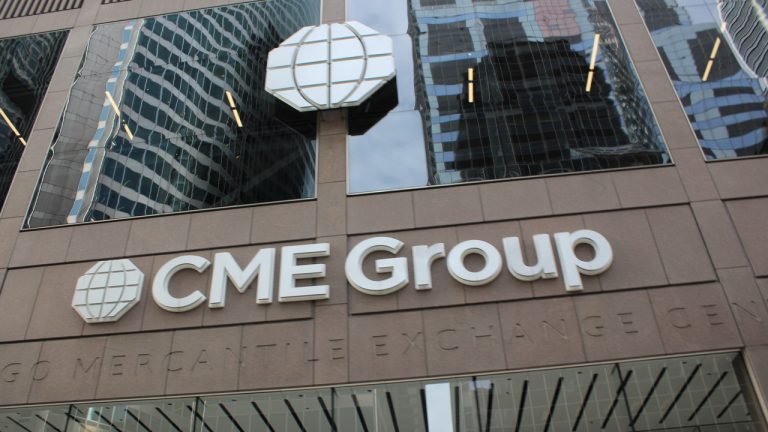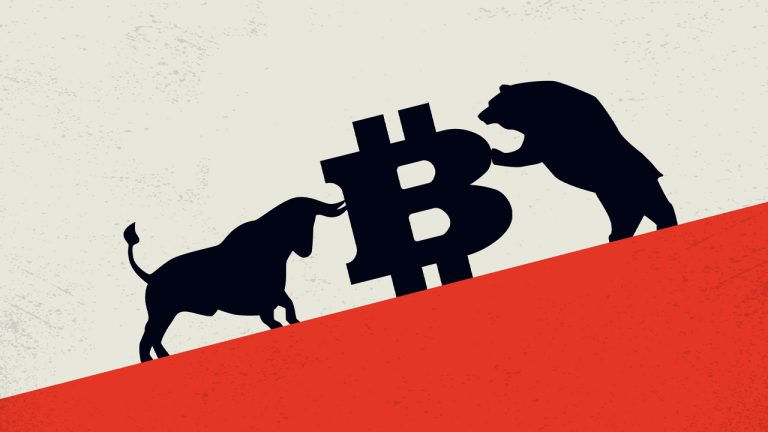 Just recently the developers behind the Bitcoin Cash-centric project Anyhedge released the alpha version of the Anyhedge Whitelabel and since then, 284 smart contracts were created onchain, and more than $32,900 in funds hedged using the alpha protocol. Furthermore, this month, General Protocols, the engineers behind Anyhedge, revealed the team plans to launch a decentralized […]
Just recently the developers behind the Bitcoin Cash-centric project Anyhedge released the alpha version of the Anyhedge Whitelabel and since then, 284 smart contracts were created onchain, and more than $32,900 in funds hedged using the alpha protocol. Furthermore, this month, General Protocols, the engineers behind Anyhedge, revealed the team plans to launch a decentralized […]
A bearish formation in the total market capitalization chart has been gaining strength after two failures to break its resistance level.
It is becoming increasingly challenging to support a bullish short-term view for cryptocurrencies as the total crypto market capitalization has been below $1.4 trillion for the past 146 days. Furthermore, a descending channel initiated in late July has limited the upside after two strong rejections.

The 1% weekly negative performance in cryptocurrency markets was accompanied by stagnation in the S&P 500 stock market index, which remained basically flat at 3,650. Uncertainty continues to limit the eventual recovery as worsening global economic conditions have caused trans-Pacific shipping rates to plunge 75% versus the previous year, forcing ocean carriers to cancel dozens of sailings.
From one side, the global macroeconomic scenario improved after the United Kingdom's government reverted plans to cut income taxes on Oct. 3. On the other hand, investors' fear increased as global investment bank Credit Suisse's credit default swaps reached their highest level on Oct. 3. Such instruments allow investors to protect against default, and their cost surpassed levels seen at the height of the 2008 financial crisis.
Below is a list of the winners and losers of the crypto market capitalization's 1% loss to $935 billion. Bitcoin (BTC) stood out with a 1% gain, which led its dominance rate to hit 41.5%, the highest since Aug. 5.

Quant (QNT) jumped 15% on speculation that its interoperable blockchain protocol would find adoption across governmental and regulatory bodies.
Maker (MKR) gained 10.6% after MakerDAO launched a proposal to decrease the stability fee for the Curve protocol staked Ether (ETH) pool.
UniSwap Protocol (UNI) gained 10.6% after UniSwap Labs, a startup contributing to the protocol, reportedly raised over $100 million from venture capitalists.
Still, a single week of negative performance is not enough to interpret how professional traders are positioned. Those interested in tracking whales and market markers should analyze derivatives markets.
For instance, perpetual futures, also known as inverse swaps, have an embedded rate usually charged every eight hours. Exchanges use this fee to avoid exchange risk imbalances.
A positive funding rate indicates that longs (buyers) demand more leverage. However, the opposite situation occurs when shorts (sellers) require additional leverage, causing the funding rate to turn negative.

Perpetual contracts reflected neutral sentiment as the accumulated funding rate was relatively flat in most cases over the past seven days. The only exception was Ether Classic (ETC), although a 0.50% weekly cost to maintain a short (bear) position should not be deemed relevant.
Since Sept. 26, the yields on the U.S. Treasury's 5-year notes declined from 4.2% to 3.83%, indicating investors are demanding fewer returns to hold extremely safe assets. The flight-to-quality movement shows how risk-averse traders are as mixed sentiment emerges from lackluster economic indicators and corporate earnings.
For this reason, bears believe that the prevailing longer-term descending formation will continue in the upcoming weeks. In addition, professional traders' lack of interest in leveraging cryptocurrency longs (buys) is evident in the neutral futures funding rate. Consequently, the current $980 billion market capitalization resistance should remain strong.
The views and opinions expressed here are solely those of the author and do not necessarily reflect the views of Cointelegraph.com. Every investment and trading move involves risk, you should conduct your own research when making a decision.
 According to a recent report, the world’s largest derivatives exchange CME Group is looking to register as a direct futures commission merchant (FCM). CME Group’s decision follows the digital currency exchange FTX, as the crypto company applied to become a derivative clearing organization and awaits approval from the U.S. Commodity Futures Trading Commission (CFTC). If […]
According to a recent report, the world’s largest derivatives exchange CME Group is looking to register as a direct futures commission merchant (FCM). CME Group’s decision follows the digital currency exchange FTX, as the crypto company applied to become a derivative clearing organization and awaits approval from the U.S. Commodity Futures Trading Commission (CFTC). If […]
Many in the space have criticized regulators including the CFTC and SEC for taking a “regulation by enforcement” approach to crypto in the United States.
The United States Commodity Futures Trading Commission, or CFTC, filed a complaint against Digitex LLC and its founder and CEO Adam Todd for failing to register the cryptocurrency futures exchange and manipulating the price of its DGTX token.
According to a Sept. 30 court filing in the Southern District of Florida, Todd allegedly pumped up the price of DGTX tokens in an effort to inflate Digitex’s holdings. The U.S. regulator claimed the Digitex CEO used different corporate entities as part of a scheme to launch and operate an illegal digital asset derivatives trading platform, in violation of the Commodity Exchange Act.
CFTC rules require performing rKnow Your Customer checks and implementing a customer information program. Todd said in 2020 that he planned to remove all KYC procedures from Digitex in an effort to protect user data.
The complaint said the CFTC sought a court order blocking Todd and Digitex from engaging in digital asset transactions considered commodities under the regulator’s purview. In addition, the regulator intended for Digitex to pay civil monetary penalties, disgorgement, and restitution to affected parties. At the time of publication, both Digitex’s and its futures websites were offline.
Related: SEC alleges fintech and 'market maker' firms manipulated crypto market in token scheme
Many in the crypto space have criticized regulators including the CFTC and Securities and Exchange Commission, or SEC, for taking a “regulation by enforcement” approach to crypto in the United States. While the SEC is currently engaged in a legal battle against Ripple over whether the firm’s XRP sales violated securities laws, CFTC commissioner Caroline Pham met with Ripple CEO Brad Garlinghouse as part of a “learning tour” on crypto and blockchain in September.

Bears have controlled BTC price by forcing 111 daily closes below $25,000 and derivatives data shows a reversal of this trend is highly unlikely.
One hundred and eleven days have passed since Bitcoin (BTC) posted a close above $25,000 and this led some investors to feel less sure that the asset had found a confirmed bottom. At the moment, global financial markets remain uneasy due to the increased tension in Ukraine after this week’s Nord Stream gas pipeline incident.
The Bank of England's emergency intervention in government bond markets on Sept. 28 also shed some light on how extremely fragile fund managers and financial institutions are right now. The movement marked a stark shift from the previous intention to tighten economies as inflationary pressures mounted.
Currently, the S&P 500 is on pace for a consecutive third negative quarter, a first since 2009. Additionally, Bank of America analysts downgraded Apple to neutral, due to the tech giant’s decision to scale back iPhone production due to "weaker consumer demand." Lastly, according to Fortune, the real estate market has shown its first signs of reversion after housing prices decreased in 77% of United States metropolitan areas.
Let's have a look at Bitcoin derivatives data to understand if the worsening global economy is having any impact on crypto investors.
Retail traders usually avoid quarterly futures due to their price difference from spot markets but they are professional traders' preferred instruments because they prevent the fluctuation of funding rates that often occurs in a perpetual futures contract.

The indicator should trade at a 4% to 8% annualized premium in healthy markets to cover costs and associated risks. The chart above shows that derivatives traders have been neutral to bearish for the past 30 days while the Bitcoin futures premium remained below 2% the entire time.
More importantly, the metric did not improve after BTC rallied 21% between Sept. 7 and 13, similar to the failed $20,000 resistance test on Sept. 27. The data basically reflects professional traders' unwillingness to add leveraged long (bull) positions.
One must also analyze the Bitcoin options markets to exclude externalities specific to the futures instrument. For example, the 25% delta skew is a telling sign when market makers and arbitrage desks are overcharging for upside or downside protection.
In bear markets, options investors give higher odds for a price dump, causing the skew indicator to rise above 12%. On the other hand, bullish markets tend to drive the skew indicator below negative 12%, meaning the bearish put options are discounted.

The 30-day delta skew has been above the 12% threshold since Sept. 21 and it's signaling that options traders were less inclined to offer downside protection. As a comparison, between Sept. 10 and 13, the associated risk was somewhat balanced, according to call (buy) and put (sell) options, indicating a neutral sentiment.
The futures and options metrics suggest that the Bitcoin price crash on Sept. 27 was more expected than not. This explains the low impact on liquidations. Despite the 9.2% correction from $20,300 to $18,500, a mere $22 million of futures contracts were forcefully liquidated. A similar price crash on Sept. 19 caused a total of $97 million in leverage futures liquidations.
From one side, there's a positive attitude since the 111-day long bear market was not enough to instill bearishness in Bitcoin investors according to the derivatives metrics. However, bears still have unused firepower, considering the futures premium stands near zero. Had traders been confident with a price decline, the indicator would have been in backwardation.
The views and opinions expressed here are solely those of the author and do not necessarily reflect the views of Cointelegraph.com. Every investment and trading move involves risk, you should conduct your own research when making a decision.
 Ironbeam is a U.S. registered Futures Commission Merchant (“FCM”) which offers trading on crypto nano futures thanks to a partnership with Coinbase Derivatives. The brokerage charges no commission* on these Bitcoin and Ethereum contracts, as well as requiring low margin.
Trade Cryptocurrency Nano Futures Contracts
Headquartered at the Chicago Board of Trade, Ironbeam launched […]
Ironbeam is a U.S. registered Futures Commission Merchant (“FCM”) which offers trading on crypto nano futures thanks to a partnership with Coinbase Derivatives. The brokerage charges no commission* on these Bitcoin and Ethereum contracts, as well as requiring low margin.
Trade Cryptocurrency Nano Futures Contracts
Headquartered at the Chicago Board of Trade, Ironbeam launched […]
Many of the top-80 cryptocurrencies dropped by 15%+ in the past week, but the Tether premium in Asia-based futures markets shows traders remain calm.
Cryptocurrencies have been in a bear trend since mid-August after they failed to break above the $1.2 trillion market capitalization resistance. Even with the current bear trend and a brutal 25% correction, it has not been enough to break the three-month-long ascending trend.
The crypto markets' aggregate capitalization declined 7.2% to $920 billion in the seven days leading to Sept. 21. Investors wanted to play it safe ahead of the Federal Open Markets Committee meeting, which decided to increase the interest rate by 0.75%.

By increasing the cost of borrowing cash, the monetary authority aims to curb inflationary pressure while increasing the burden on consumer finance and corporate debt. This explains why investors moved away from risk assets, including stock markets, foreign currencies, commodities and cryptocurrencies. For instance, WTI oil prices ceded 6.8% from Sept. 14, and the MSCI China stock market index dropped 5.1%.
Ether (ETH) also saw a 17.3% retrace during the 7-day period and many altcoins performed even worse. The Ethereum network Merge and its subsequent impact on other GPU-mineable coins caused some skewed results among the worst weekly performers.

Chiliz (CHZ) rallied 21.5% following two successful fan token launches from MIBR esports team and the VASCO soccer team from Brazil.
XRP gained 16.6% after Ripple Labs called for a federal judge to immediately rule whether the company's XRP token sales violated U.S. securities laws.
ApeCoin (APE) gained 15% as the community expects the staking program to launch, which shall be detailed by Horizen Labs on Sept. 22.
RavenCoin (RVN) and Ethereum Classic (ETC) retraced most of their gains from the previous week as investors realized the hash rate gains from Ethereum miners did not necessarily convert into higher adoption.
The OKX Tether (USDT) premium is a good gauge of China-based crypto retail trader demand. It measures the difference between China-based peer-to-peer trades and the United States dollar.
Excessive buying demand tends to pressure the indicator above fair value at 100%, and during bearish markets, Tether’s market offer is flooded, causing a 4% or higher discount.

The Tether premium currently stands at 100.7%, its highest level since June 15. While still under the neutral area, the indicator showed a modest improvement over the past week. Considering that crypto markets tanked by 7.2%, this data should be viewed as a victory.
Perpetual contracts, also known as inverse swaps, have an embedded rate that is usually charged every eight hours. Exchanges use this fee to avoid exchange risk imbalances.
A positive funding rate indicates that longs (buyers) demand more leverage. However, the opposite situation occurs when shorts (sellers) require additional leverage, causing the funding rate to turn negative.

As depicted above, the accumulated 7-day funding rate was negative for every altcoin. This data indicates excess demand for shorts (sellers), although it could be dismissed in Ether’s case because investors aiming for the free fork coins during the Merge likely bought ETH and sold futures contracts to hedge the position.
More importantly, Bitcoin's funding rate held slightly positive during a week of price decline and potentially bearish news from the FED. Now that this critical decision has been made, investors tend to avoid placing new bets until some new data provides insights on how the economy adjusts.
Overall, the Tether premium and futures' funding rate show no signs of stress, which is positive considering how badly crypto markets have performed.
The views and opinions expressed here are solely those of the author and do not necessarily reflect the views of Cointelegraph. Every investment and trading move involves risk. You should conduct your own research when making a decision.

Bitcoin price dropped to $18,270, but derivatives traders didn’t flinch. Here is why.
Bitcoin (BTC) faced a 9% correction in the early hours of Sept. 19 as the price traded down to $18,270. Even though the price quickly bounced back above $19,000, this level was the lowest price seen in three months. However, pro traders held their ground and were not inclined to take the loss, as measured by derivatives contracts.

Pinpointing the rationale behind the crash is extremely difficult, but some say United States President Joe Biden's interview on CBS "60 Minutes" raised concerns about global warfare. When responding to whether U.S. forces would defend Taiwan in the event of a China-led invasion, Biden replied: "Yes, if in fact, there was an unprecedented attack."
Others cite China's central bank lowering the borrowing cost of 14-day reverse repurchase agreements to 2.15% from 2.25%. The monetary authority is showing signs of weakness in the current market conditions by injecting more money to stimulate the economy amid inflationary pressure.
There is also pressure from the upcoming U.S. Federal Reserve Committee meeting on Sept. 21, which is expected to hike interest rates by 0.75% as central bankers scramble to ease the inflationary pressure. As a result, yields on the 5-year Treasury notes soared to 3.70%, the highest level since November 2007.
Let's look at crypto derivatives data to understand whether professional investors changed their position while Bitcoin crashed below $19,000.
Retail traders usually avoid quarterly futures due to their price difference from spot markets, but they are professional traders' preferred instruments because they prevent the fluctuation of funding rates that often occurs in a perpetual futures contract.

The indicator should trade at a 4% to 8% annualized premium in healthy markets to cover costs and associated risks. Thus, one can safely say that derivatives traders had been neutral to bearish for the past two weeks as the Bitcoin futures premium held below 2% the entire time.
More importantly, the shakeout on Sept. 19 did not cause any meaningful impact on the indicator, which stands at 0.5%. This data reflects professional traders' unwillingness to add leveraged short (bear) positions at current price levels.
One must also analyze the Bitcoin options to exclude externalities specific to the futures instrument. For example, the 25% delta skew is a telling sign when market makers and arbitrage desks are overcharging for upside or downside protection.

In bear markets, options investors give higher odds for a price dump, causing the skew indicator to rise above 12%. On the other hand, bullish trends tend to drive the skew indicator below negative 12%, meaning the bearish put options are discounted.
The 30-day delta skew had been near the 12% threshold since Sept. 15, and signaled that options traders were less inclined to offer downside protection. The negative price move on Sept. 19 was not enough to flip those whales bearish, and the indicator currently stands at 11%.
Related: Bitcoin, Ethereum crash continues as US 10-year Treasury yield surpasses June high
Derivatives metrics suggest that the Bitcoin price dump on Sept. 19 was partially expected, which explains why the $19,000 support was regained in less than two hours. Still, none of this will matter if the U.S. Federal Reserve raises the interest rates above the consensus or if stock markets collapse further due to the energy crisis and political tensions.
Therefore, traders should continuously scan macroeconomic data and monitor the central banks' attitude before trying to pin a flag on the ultimate bottom of the current bear market. Presently, the odds of Bitcoin testing sub-$18,000 prices remain high, especially considering the weak demand for leverage longs on BTC futures.
The views and opinions expressed here are solely those of the author and do not necessarily reflect the views of Cointelegraph. Every investment and trading move involves risk. You should conduct your own research when making a decision.
 The price of bitcoin has dropped 72.9% in USD value since the crypto asset’s all-time high ten months ago and recently, bitcoin’s been trading for just under $19K per unit. This week two prominent crypto market influencers have been discussing how governments could suppress bitcoin markets by shorting the crypto asset. However, one of the […]
The price of bitcoin has dropped 72.9% in USD value since the crypto asset’s all-time high ten months ago and recently, bitcoin’s been trading for just under $19K per unit. This week two prominent crypto market influencers have been discussing how governments could suppress bitcoin markets by shorting the crypto asset. However, one of the […]
A majority of “traders” end up being losers with empty portfolios. Here is exactly why.
A quick flick through Twitter, any social media investing club, or investing-themed Reddit will quickly allow one to find handfuls of traders who have vastly excelled throughout a month, semester, or even a year. Believe it or not, most successful traders cherry-pick periods or use different accounts simultaneously to ensure there’s always a winning position to display.
On the other hand, millions of traders blow up their portfolios and turn out empty-handed, especially when using leverage. Take, for example, the United Kingdom’s Financial Conduct Authority (FCA) which requires that brokers disclose the percentage of their accounts in the region that are unprofitably trading derivatives. According to the data, 69% to 84% of retail investors lose money.
Similarly, a study by the U.S. Securities and Exchange Commission found that 70% of foreign exchange traders lose money every quarter, and eToro, a multinational broker with 27 million users, reported that nearly 80% of retail investors lost money over 12 months.
The same pattern emerges in every market across different continents and decades: retail traders seldom sustain profitable operations. Still, novice and experienced investors think they can overcome that bias due to ingenuity or mass marketing campaigns from influencers, exchanges and algorithmic trading systems.
Below are the 4 culprits behind the inevitable failure of retail traders. There is no easy solution aside from a long-term mentality and dollar-cost average-based strategy of buying a fixed amount every week or month.
In June 2021, the U.S. Financial Industry Regulatory Authority fined Robinhood $70 million, alleging “widespread and significant harm” and “misleading information to millions of its customers” starting in September 2016. Specifically, the regulator cited the platform’s outages between 2018 and 2018, affecting clients’ ability to execute buy and sell orders during significant market volatility periods.
On 8 March 2022, London Metal Exchange (LME), the largest commodities trading venue in Europe, canceled all the trades in nickel futures and deferred the delivery of all physically settled contracts. The reason cited by Bloomberg was “unprofitable short positions, in a massive squeeze that has embroiled the largest nickel producer as well as a major Chinese bank.”
Notice that such a decision is vastly worse for a broker that decides to deliberately halt their platform. In those cases, at least the client can choose another intermediary. A rollback, or trade cancellation, is far more problematic because users had already expected the profits, or maybe even hedged, meaning the trade was part of a broader strategy.
Professional traders use colocation servers, placing a server as close as possible close to an exchange's data center because this significantly reduces transmission delays. These exchanges offer premium services to high-end clients, including the private housing servers on-site.
Besides requiring a significant amount of volume to cover the costs, colocation servers provide high-frequency traders the benefit of running strategies such as pinging, which uses a series of smaller orders to scope whales trying to enter or exit the market.
In addition to being heavily funded, these arbitrage traders usually have additional funding from exchanges. These benefits basically mean they can post trades with no collateral, similar to having credits, providing them with a huge advantage over retail investors.
The evidence? Three Arrows Capital's (3AC) insolvency negatively impacted Deribit exchange, which was forced to cover the loss themselves. Moreover, prominent Bitcoin Cash (BCH) figure, Roger Ver, is being sued by the exchange CoinFLEX for $84 million allegedly owed due to liquidations.
Retail traders need to understand that there is no room for amateurs and realize the intricate relationship between exchanges, venture capitalists, market makers and whales. Whether or not a partnership is on paper, a mutual benefit ensures that these players have preferential access to pre-seed funding rounds, listings and market access.
The only way for investors to opt out of losing money is to give up on trading, and avoid leverage trading like the plague. In reality, investors with six months or longer timeframe stand a chance of being profitable in each of their positions.
The views and opinions expressed here are solely those of the author and do not necessarily reflect the views of Cointelegraph. Every investment and trading move involves risk. You should conduct your own research when making a decision.